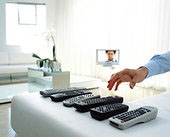When Microsoft introduced its long-awaited Xbox 360 console on May 12 in an MTV special, its intentions went beyond just fun and games, The company called the long-awaited product a “future-generation game and entertainment system.” While Xbox 360 promises to offer video games compatible with HDTV, fast processing and a lot of memory, Microsoft also noted that the system can play DVDs and CDs, stream music from MP3 players, and network with the company’s “Media Center” PCs to stream digital content around the house, among other tasks.
Microsoft’s market: The increasingly crowded living room. In fact, the parade of technology companies targeting home entertainment is a long one. Dell Computer sells TVs. Apple Computer’s iMac Mini is viewed by analysts as a potential entertainment server. Media-ready PCs abound from the likes of Hewlett-Packard. These technology stalwarts are selling wares that were typically offered by consumer electronic giants such as Sony. But do they have what it takes to compete in your living room? Is the so-called digital living room — in which audio and visual content is available on demand and combined with Internet and other applications in one seamless environment — fact or fantasy? Who will the winners ultimately be? Wharton experts say the digital living room is becoming a reality, but slowly.
The vision of the digital living room isn’t new. Some form of it has been pitched for decades. Interactive TV was introduced in the 1980s. Microsoft created a digital home as a prototype in 1994 and has dabbled with everything from WebTV to game systems. The digital living room “vision” has evolved to a level where content of all forms is delivered according to highly personalized specifications along with Internet service on one box — a kind of home entertainment server.
Are we there yet? Not quite, but we are getting closer. “It seems like people have been predicting the digital living room for 10 years,” says Wharton marketing professor Barbara Kahn. “It has been going slowly, but the notion of watching TV on your phone or computer is not that far away.”
Indeed, many components of the digital living room are in place today. Video-on-demand service is available through most cable providers. Music and video can be pumped through computer networks wirelessly. Televisions and computers are largely made from similar components. Gaming devices can play DVDs and connect to the Internet. “There won’t be one day when everything becomes digital, but we have moved a lot farther than people realize,” says Wharton legal studies professor Kevin Werbach.
Nevertheless, there’s a long way to go. Eric Clemons, professor of operations and information management at Wharton, says digital content on demand is really just a start. “Once we have digital [content] on demand, why stick with standard content?” asks Clemons. “I can make a Rocky movie that has only the fight scenes, or redo Casablanca. It’s hard to do that with traditional television or media.”
Devices Don’t Play Well Together
Wharton marketing professor Peter Fader says that whether the digital living room is a fact or fiction depends on your time frame. “In the longer view it’s a fact, but it’s going to be an evolution,” says Fader. “You can throw all the technology in the world at the living room, and people may not jump to it.” Werbach agrees, arguing that the general notion that the living room will be connected to home computers is accurate. The problem is carrying out that vision.
Just like companies that have a hard time connecting various hardware and software platforms, consumers who try to go digital with all of their entertainment will have integration issues. “The vision leaves out the technology sophistication required of consumers,” says Werbach. “You have Wi-Fi and wired connections to integrate, and there’s a lot to move around.”
Meanwhile, many devices don’t play nicely together. Apple’s iPod songs don’t play on the Windows Media player, and vice versa. In most cases, a Sony TV can’t communicate automatically with home PCs. And then there’s the conundrum around having separate boxes for every entertainment function — music, digital video recording, DVD players and the like. Standards are just being formed, but there are turf wars as players such as Microsoft, Sony and Comcast jockey for position. The problem is compounded by another fact: Consumer electronics product cycles take a long time. A television could last 15 years compared to a PC that may be replaced in four years, says Werbach. That means the latest technology takes a long time to reach television sets.
Meanwhile, Fader says the whole concept of the digital living room needs other things to fall into place first. For instance, broadband penetration needs to be at 100% for consumers to get audio, video and web access pumped into their home networks. Nevertheless, the living room gadgets keep coming. “All of the technology providers need to keep their toes in the water, just in case,” says Fader.
Whether these gadgets collect dust or become dominant will rest on one thing — ease of use. “In order to take off, it has to be easy,” says Werbach. “It’s not easy yet.”
The Race to Earn a Halo
So what makes the idea of the digital living room so appealing to technology suppliers? According to experts at Wharton, it’s a matter of extending brands to grow sales and revenue. If a company like Microsoft can dominate the living room, its software could be everywhere in every facet of life. A company like Dell can take the same parts it uses for displays to manufacture and sell televisions.
In many cases, the move to target consumers makes sense even if profit margins are lower, says Clemons. “Things like (Nintendo’s) Gameboy or Xbox may be low margin, but sometimes they are not — like iPod,” he says. “But the content is generally not low margin, so if Apple or Microsoft can own a piece of the content business they can sell content as well.”
Clemons says the other appeal of branching out to more consumer products is the so-called “halo effect” — the Holy Grail that Apple is pursuing with success. By selling iPods, Apple has managed to sell more of its other products such as its iMac. For the fiscal second quarter that ended on March 26, Apple reported net income of $290 million, compared to $46 million a year ago. Apple shipped 5,311,000 iPods during the quarter, up 558% from a year ago. The iPod’s success also had an effect on the shipments of Apple’s Macintosh computers. Apple shipped 1,070,000 computers in the quarter, up 43% from a year ago. “Apple is firing on all cylinders,” said Steve Jobs, Apple’s CEO, in a press release.
Indeed, Apple offers a host of components that could eventually be used to create a digital living room. Fader says one of Apple’s most underrated products is the “AirPort Express,” a small, plug-in device that can connect to the Internet, print and stream iTunes music throughout home networks wirelessly.
According to Clemons, the company that can piece together a digital living room and offer customers all the entertainment they want in any format will be the big winner. “What makes home entertainment technology so attractive now is that, ultimately, we will all have exactly what we want when we want it.”
Consumers Move Slowly
However, convincing consumers they need a digital living room is another matter. In November 2004, Intel and Microsoft announced a marketing campaign to promote “Digital Joy” in the living room, including television, print, cinema and online advertising, as well as “experience zones” to tout their best digital entertainment technology.
That’s just the latest effort to promote digital entertainment in the household. Since 1994, Microsoft has equipped its concept facility, called “Microsoft Home,” with new technologies that demonstrate how software might help people better manage their lives. In May 2005, Microsoft opened a new Microsoft Home in London to specifically promote the “digital lifestyle.”
The problem: Consumers are slow to move. Werbach says there is a lot to be learned from TiVo, which makes a digital recording device that allows consumers to watch TV shows at their leisure and rewind live events. “TiVo is an extraordinary product and people love it,” says Werbach. “But it is still a tough sell to people who don’t have it.”
Technology vendors branching out into new markets also have to overcome perception hurdles. Many consumers don’t associate companies like Microsoft and Hewlett Packard with home entertainment. Kahn acknowledges the challenges, but says that in many cases being a player in the digital living room is a good way to extend brands into new markets. If Apple is a leader in online music, why shouldn’t an iPod be the core of an entertainment center? And since Apple preaches the digital lifestyle, why can’t its iMac Mini be a de facto entertainment server managing video, music and photos? “Brand extensions can really work,” says Kahn, especially “when there’s at least an association with a new category.”
The big risk is that companies may reach too far. Kahn makes the distinction between brands that are focused on a core group of consumers and companies that are focused on products. For instance, Apple targets creative people, who are loyal to the computer maker and its products. Dell is a company that is known for being efficient. Between the two, it may be tougher for Dell to be viewed as a home entertainment company, suggests Kahn, adding that companies that are focused on users have an easier time extending brands.
To be sure, there will be a few fumbles as technology vendors try to extend their brands, says Clemons. “The biggest difficulty is that this is simply not what any of them do.”
Where is Sony?
While the future of the digital living room is uncertain, most agree that Sony has left the door open for technology vendors to take over home entertainment. “Sony has missed so many opportunities,” says Fader. Perhaps the biggest flub was Sony’s failure to produce an iPod-like gadget, even though it was a leader in portable music with its Walkman products. “Sony should have sold ‘sPods’ long before Apple,” adds Clemons. “Sony is one of the dominant players in digital content and it surely could have made both a ‘sPod’ and a quality online music store before Apple did.”
Nevertheless, it’s too early to count Sony out. It has a hit with its Sony PlayStation, but it’s unclear whether that product will become an entertainment hub. Sony’s portable PSP PlayStation has also been well received and can play music and movies as well as games.
“Sony brings a lot of assets to the table,” says Werbach. “But its challenge is its ‘not invented here’ attitude.” Historically, Sony has tried to make its own technology the standard, but that strategy has backfired, as in the case of its Betamax video cassette recorder, which was eventually upended by the standard VHS VCR. And until recently, Sony’s digital music players mostly played its own proprietary digital music format; Sony players now support other files such as MP3s. “Sony wants everything to be on Sony equipment, but it could play a bigger role if it integrated everything together.”
Any Winners?
Although the reasons why companies want to be at the center of a digital living room are easy to spot, the potential winners aren’t. Perhaps the PC will assume the role of television. Maybe big consumer brands such as Sony and Samsung will continue to dominate. Perhaps a company like Yahoo! or Google will wind up being the glue in home entertainment. After all, their portals are already accustomed to delivering entertainment, video, news and audio. “When a revolution occurs, it’s usually through a company that you never anticipated,” says Fader. That company could be Apple finding more uses for its iPod, or maybe even the company that makes podcasting mainstream. Or, perhaps Microsoft’s Xbox will become an entertainment server for future generations.
Wharton experts were mixed on Microsoft’s ultimate success. “It may be harder for software companies to branch out,” says Werbach. “And then there’s the challenge of building an operating system for a PC versus a TV. No one wants to reboot their TV.”
“We only know who the winners are and why they won in retrospect,” notes Fader. “There’s just no valid way of predicting it.” Clemons predicts that Apple will be the only company “quirky enough” to combine innovative design, hardware, software and content into a living-room package that appeals to the masses.
One consolation: There will be plenty of time to watch the digital living room develop. “Adoption is likely to be a generational thing,” says Fader. “I doubt we will participate, but our children who are gifted at multitasking will demand it.”



